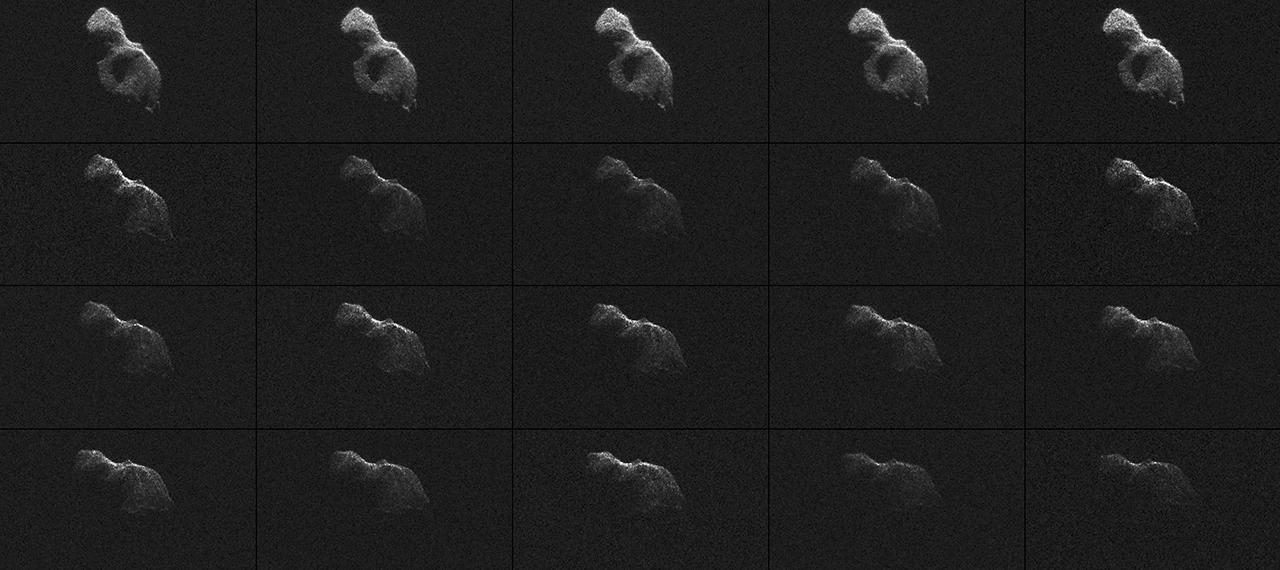'The Beast' Asteroid Seen in Amazing Detail (Photos, Video)
The nature of "The Beast" has been revealed.
NASA researchers bounced radio signals off the huge near-Earth asteroid 2014 HQ124, nicknamed "The Beast" by some, as it whizzed by Earth on Sunday (June 8), just six weeks after it was discovered. The resulting images — which resolved features as small as 12 feet (3.75 meters) wide — are among the most detailed radar views of an asteroid ever acquired, according to agency officials.
The Earth-based radar observations taken over four hours on Sunday revealed that the asteroid is at least 1,200 feet (370 m) wide. The images show the asteroid likely is made up of two lobes, which may have been separate once but are now fused together, giving it a shape resembling a lumpy bowling pin or chicken drumstick. [Potentially Dangerous Asteroids (Images)]

"This may be a double object, or 'contact binary,' consisting of two objects that form a single asteroid with a lobed shape," said Lance Benner of NASA's Jet Propulsion Laboratory in Pasadena, California.
Benner and colleagues also observed a pointy hill jutting from the middle of the asteroid and discovered that "The Beast" spins around about once every 24 hours.
Asteroid 2014 HQ124 approached Earth at a relatively close distance early Sunday, coming within 777,000 miles (1.25 million kilometers) at its nearest approach, or about 3.25 times the distance from Earth to the moon.
Traveling at a speed of 31,000 mph (50,000 km/h) relative to Earth, the space rock flew by safely and never posed any threat of a collision with the planet. However, if an asteroid this size did slam into Earth, it could unleash catastrophic damage, with the potential to wipe out an entire metropolitan area, researchers said.
Get the Space.com Newsletter
Breaking space news, the latest updates on rocket launches, skywatching events and more!
To create these new views of "The Beast," Benner and colleagues beamed a radio signal at the asteroid from the 230-foot (70 m) Deep Space Network antenna at Goldstone, California. The signal bounced back and was received by two other radio antennas on the ground — a small, 112-foot (34 m) antenna about 20 miles (32 km) away from the DSN antenna at Goldstone and the 1,000-foot (305 m) Arecibo radio telescope in Puerto Rico.
"By itself, the Goldstone antenna can obtain images that show features as small as the width of a traffic lane on the highway," said Benner. "With Arecibo now able to receive our highest-resolution Goldstone signals, we can create a single system that improves the overall quality of the images."

Follow Megan Gannon on Twitter and Google+. Follow us @Spacedotcom, Facebook or Google+. Originally published on Space.com.
Join our Space Forums to keep talking space on the latest missions, night sky and more! And if you have a news tip, correction or comment, let us know at: community@space.com.

Megan has been writing for Live Science and Space.com since 2012. Her interests range from archaeology to space exploration, and she has a bachelor's degree in English and art history from New York University. Megan spent two years as a reporter on the national desk at NewsCore. She has watched dinosaur auctions, witnessed rocket launches, licked ancient pottery sherds in Cyprus and flown in zero gravity on a Zero Gravity Corp. to follow students sparking weightless fires for science. Follow her on Twitter for her latest project.









